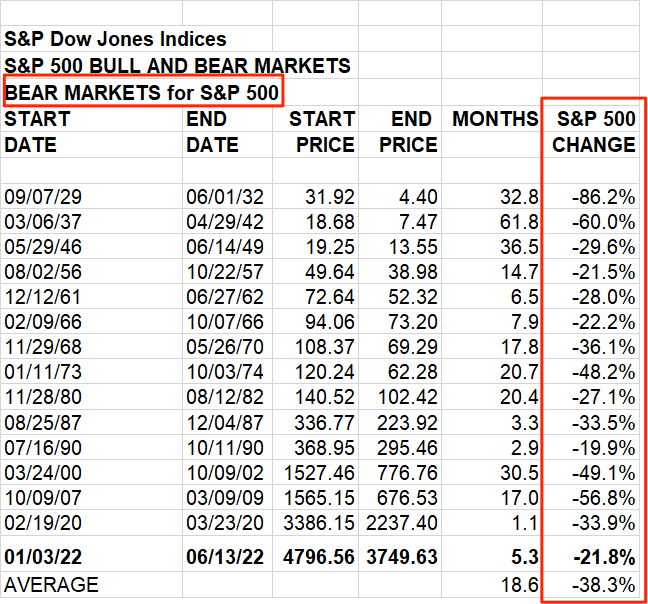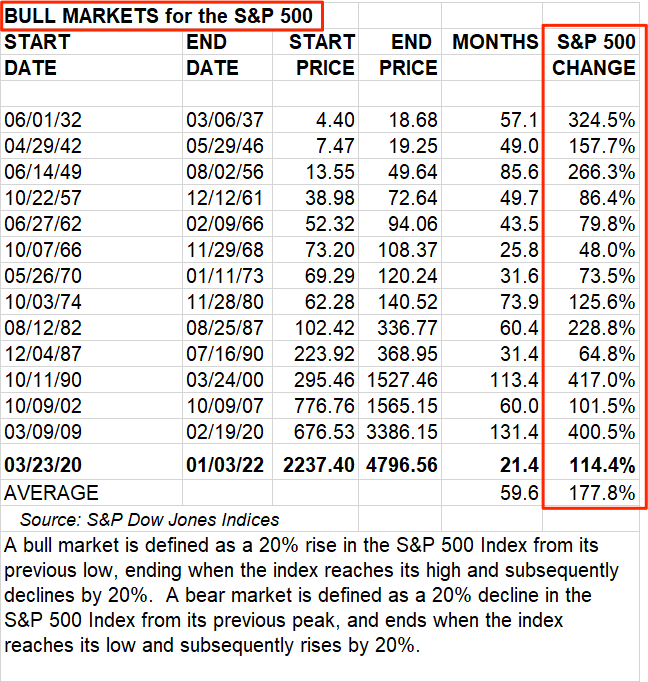
Even though I don’t check my retirement account balances daily (or weekly, or often monthly) it can still be nearly impossible to tune out all the market noise. I was promptly notified via e-mail press release that the S&P 500 index officially reached “Bear Market” status today 6/13/2022. A bear market is defined as a 20% drop from previous high, ending when the index reaches a low and subsequently rises by 20%.
The email also included this handy list of every bear market in the history of the S&P 500 index (since 1928). Credit to S&P Dow Jones Indices:

Takeaway: You should always be prepared for a drop of 50% in your stock holdings. Enduring such uncomfortable volatility is the price of investing in stocks, and if you don’t pay it, you don’t get the full returns.
I’ve yet to find anyone with a clear way to avoid these swings. Beyond buy-and-hold, perhaps the only thing is to wait only for the “fat pitches”, which are rare and far between. Even then, will you have the guts to swing? This is why I think of my primary portfolio as the “Humble Portfolio”.
Here is list of every bull market in history. A bull market is defined as 20% rise from the previous low, ending when the index reaches a high and subsequently drops by 20%.

Takeaway: The bull markets more than make up for the bear markets over the long run. At some point, you will be reminded that in order to make up for a 50% drop, stocks would have to go up by 100% just to break even again. That’s sounds like a lot, but in fact that has happened repeatedly and then some. You can see in the chart that this most recent bull market was a +400% change, and that doesn’t even include dividends.
Every one needs to find a good balance through education and experience where they can hold the risky stuff through the bad times, while also be happy holding the boring stuff through the “but my neighbor got rich daytrading crpyto” times. We are currently going through another period of heightened uncertainty. How do you feel about your portfolio today?
“History doesn’t repeat itself but it often rhymes.” – attributed to Mark Twain
Photo credit: Unsplash
 The Best Credit Card Bonus Offers – 2025
The Best Credit Card Bonus Offers – 2025 Big List of Free Stocks from Brokerage Apps
Big List of Free Stocks from Brokerage Apps Best Interest Rates on Cash - 2025
Best Interest Rates on Cash - 2025 Free Credit Scores x 3 + Free Credit Monitoring
Free Credit Scores x 3 + Free Credit Monitoring Best No Fee 0% APR Balance Transfer Offers
Best No Fee 0% APR Balance Transfer Offers Little-Known Cellular Data Plans That Can Save Big Money
Little-Known Cellular Data Plans That Can Save Big Money How To Haggle Your Cable or Direct TV Bill
How To Haggle Your Cable or Direct TV Bill Big List of Free Consumer Data Reports (Credit, Rent, Work)
Big List of Free Consumer Data Reports (Credit, Rent, Work)
Here I am again, in the Debbie Downer role. The real difficulty in this type of analysis is that we are not conducting an experiment involving fruit flies or yeasts—the investing public has modified its strategy based on staring at tables like these for decades. This staring has led many to conclude that, given enough time, any diversified stock market purchase will ultimately be profitable. Sadly, there is no way to prove that this is anything but a self-fulfilling prophecy. If people believe the market will recover—and that belief is well-enough ingrained to withstand harsh challenge—they will endure what they otherwise would have escaped. Until one day there is a jump discontinuity. This is the lesson of the long (and I mean LONG) arc of history; people believing their god would never allow for the destruction of his temple, people believing they and their children and their children’s children would always find work at the plant. Investors should study the *first* edition of Graham and Dodd, look at the screaming discrepancies between corporate valuations and tangible corporate assets, recall that this was the material that nourished the likes of Warren Buffett, decide whether one can still draw the same conclusions given current conditions. My biggest argument is with the principle “no matter what you pay for a diversified portfolio of stocks, you will ultimately be ahead given enough patience.” Stripped bare, this is nothing but a martingale gambling system.
You make valid points and I am sympathetic to many of them. Widespread adoption may lead to raised valuations and lower future average returns. But my counter-question would be: Even though buy-and-hold is not ideal, what is better? Timing in and out? If so, how, based on some sort of valuation rule? Accepting lower bond returns that may not keep up with inflation? I just don’t see a better, more realistic solution.
My response to the question “what is better” is: we cannot simply adopt “autopilot” strategies; we must always be thinking about what we are doing. So a buy and hold strategy is a likely a good one, but a Monte Carlo analysis based on historical data that says “I have a 97% chance of being fine with this portfolio” is nonsense. So maybe don’t bet the farm on that Monte Carlo analysis working out. I personally have a larger allocation in real property investments than I have in stocks; that’s because I can articulate specific reasons why my investments are sound. Reasons like: I am invested in starter homes in areas that should thrive under conditions we can reasonably project from climate change. I am invested in starter homes because (1) if rates rise, people with very low rate mortgages are unlikely to “trade up” to homes that will require an 8% mortgage rather than the 2% mortgage they have now; (2) young adults have been deferring their purchase of “first homes” in droves due to COVID, rising costs, etc. and here is substantial pent-up demand. This is the kind of thinking that drove the first edition of Graham and Dodd’s “Security Analysis” (it’s the only edition I’ve spent any time reading). Do I know I am right? Absolutely not. Am I backed by a Monte Carlo analysis that says my retirement is X% secure? No. I am backed by my belief that reason is all we have, and we must never abandon it.
I appreciate posts like this, it’s good to have a visual representation to refer to showing the ups and downs of the market. The market always goes up (though it may take a while), even through world wars, pandemics, and even the financial system almost collapsing.
Very illustrative. Thank you. for this!
Interesting and I found it quite surprising that no one has a consistent and dependable way to sidestep bear market crashes. I took it upon myself to figure it out for myself in 2019 and it was not too difficult. It only took about 3 months of analyzing every bear market back to 1929 as you outlined in your article. I’ll be launching a newsletter soon on this topic. Bear markets are made up of two parts – crash and recovery. The crash segment of the bear market is only 25% of the bear cycle. The recovery segment makes up about 75% of the bear cycle. And full bear market cycles represent about 47% of S&P 500 trading days. Non bear markets represent 53% of S&P 500 trading days. So bear market crash segments only represent about 12% of S&P 500 trading days. You want to be fully invested about 88% of the time and just need a strategy to navigate the infrequent (12%) but painful bear market crashes. Using a set of algorithms with this aim in mind, it is not hard to take S&P 500 annual returns of roughly 8% per year (without dividends) to 20% per year (without dividends). And best of all, this strategy results in only 5% declines in bear crashes compared to the average 37% decline of the S&P 500 in bear market crashes. After beating the returns of the S&P 500 by many multiples since 2019, it has taken me two years to realize why this isn’t being done. I finally realized that it is not because it is not possible, but that it is because the financial services industry does not want people to know that it is possible. I have been in cash since January of this year (missing most of the fall) and investment firms don’t make any fees when people sit in cash. Investment advisors are not paid for results, only assets under management. So they are not incentivized to raise returns. They also don’t want to do the extra work required to do this kind of trading even though it only happens once every few years. Everyone has been brainwashed into the Buy and Hold mentality. Markets do always rebound but why should investors accept declines of 30, 40, 50 or 60% when they can be avoided? Mind boggling.
Interesting perspective Phil. Where’s the newsletter?
I thought timing the market doesn’t work?